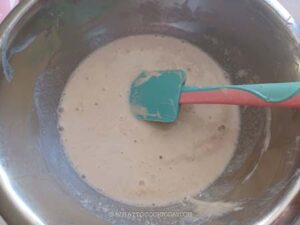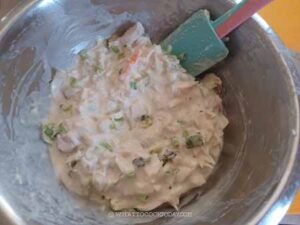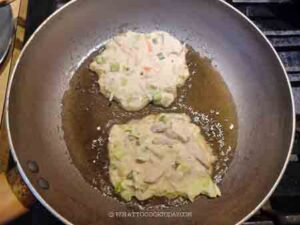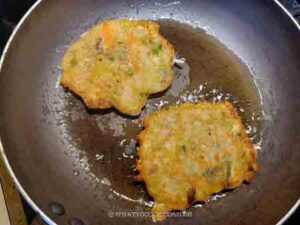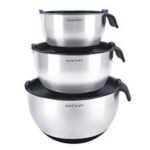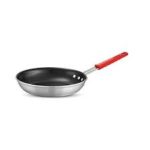This post may contain affiliate links. Please read our disclosure policy.
These sourdough discard yachae jeon are a creative and tasty way to reduce waste while making a flavorful dish perfect for snacking, as a side dish, or even a light meal.

What is yachae jeon?
The name yachae jeon comes from “yachae,” meaning vegetables, and “jeon,” meaning pan-fried dish. Yachae jeon is a popular Korean savory pancake made with various vegetables mixed into a batter and pan-fried until crispy on the edge. Traditionally enjoyed as a snack, appetizer, or side dish, it has a delightful combination of crunchy edges and tender centers.
What is sourdough discard yachae jeon then?
While these pancakes are often made with a basic flour batter, incorporating sourdough discard adds a unique tangy flavor that enhances their taste. My kids love these sourdough discard version of yachae jeon. Perhaps they have eaten enough sourdough bread that I baked often at home, they love that hint of tang in the pancakes
Sourdough Discard Korean Veggie Pancakes (Yachae Jeon)
Ingredients
Pancake batter:
- 240 g sourdough discard
- 14 g rice flour
- ½ tsp baking powder
- ¾ tsp salt
- 2 tsp sesame oil
- 1 tsp garlic powder
- 120 g water
Vegetables:
- 100 g Shredded cabbage
- 70 g Shredded carrots
- 60 g zucchini seeded and grated
- 3 stalks green onion thinly sliced or finely chopped
Dipping sauce:
- 2 Tbsp soy sauce
- 1 Tbsp rice vinegar
- ½ tsp sugar
- 1 tsp sesame oil
- 1 tsp sesame seeds
For pan-frying:
- oil
Instructions
Prepare the batter:
- You wan to make sure you squeeze out any excess liquid from the veggies you use, especially zucchini. I like to remove the seeds, sprinkle a bit of salt and toss them and let them sit for 15-20 minutes and then squeeze out excess moisture. The excess moisture affects the consistency of the batter
- Combine all ingredients for the batter in a mixing bowl. The batter is medium thick

- Cover and let the batter rest for 30 minutes in the fridge. This resting time allow the flour to get hydrated and it also helps to improve the texture of the pancakes
- When ready to cook the pancakes, remove the batter from the fridge. Add the veggies and gently mix them

Cooking the pancakes:
- Preheat a large non-stick frying pan (about 10-12 inches is ideal) with about 2 Tbsp of oil, over medium heat.
- Instead of making large pancakes, I prefer to make them in smaller sizes. Spoon about 2-3 Tbsp of the batter on the pan. You can probably fit another one or two batter on there. Cook for about 2-3 minutes or until the edge is crisp and the bottom is golden brown. Don't flip too early. Once it's golden brown, flip to the other side and cook for another 2-3 minutes or until they are crispy on the edges

- Remove the pancakes and put on absorbent paper towel to absorb excess grease. Transfer to a cooling rack set on top of a baking pan. Keep this warm in the oven. This helps to keep the pancakes from getting soggy

- Repeat with the rest of the batter. Remember to add more oil each time. If you don't use enough oil, the pancakes won't turn out good. Make sure to reheat the oil again before cooking the pancakes
To serve:
- Serve with the dipping sauce on the side. They are the best served immediately
- You can read more details on variations and other tips in my post that may answer your questions not covered in the recipe card
RECOMMEDED TOOLS
*Nutrition facts are just estimates and calculated using online tools*

Tips for Making Perfect Yachaejeon with Sourdough Discard:
1. Balance the batter consistency
The key to crispy pancakes is getting the right consistency of the batter. It should be thick enough to coat the vegetables but not too dense. If the batter is too runny, the pancakes won’t crisp up as well; if too thick, they’ll be heavy.
2. Don’t overcrowd the pan
Cooking the pancakes in smaller batches ensures even browning and crispiness. Overcrowding leads to steaming rather than frying, which softens the texture.
3. Adjust heat carefully
Cook the pancakes on medium heat. Too high, and the outside will burn before the inside cooks; too low, and they’ll absorb oil and become soggy.
4. Let the batter rest
Allow the batter to sit for 30 minutes before cooking to let the flour fully hydrate. This resting time helps improve texture and flavor.

You can try several delicious variations with Korean pancakes (jeon) to keep things exciting and versatile. Here are a few ideas for changing up this basic sourdough discard yachaejeon:
1. Seafood Pancakes (Haemuljeon): You can use shrimp, squid, mussels, or any seafood you like. Chop the seafood into bite-sized pieces and mix them into the batter. Seafood adds a juicy, savory flavor that pairs well with the tanginess of the sourdough discard.
2. Kimchi Pancakes (Kimchijeon): For a more intense flavor, you can use chopped, well-fermented kimchi and a bit of kimchi juice to replace some of the water in the recipe. Kimchi adds a spicy, tangy kick and extra depth to the pancakes.
3. Meat Pancakes: Thin slices of pork belly, beef, or ground meat will be perfect for this. I have use leftover shredded rotisserie chicken meat. If the meat is raw, make sure to cook the meat thoroughly as it fries with the batter.
4. Mushroom Pancakes: you can use shiitake, oyster, or enoki mushrooms. Mushrooms provide an umami-packed, earthy flavor. Chop them into smaller pieces and then cook them dry on the pan and let them release the liquid, otherwise this extra liquid affects the consistency of your pancakes.
5. Cheese Pancakes: You can use shredded mozzarella, cheddar cheese or any cheese of your choice. Cheese adds a gooey, melty center and a savory flavor. You can mix it into the batter or sprinkle it on top halfway through cooking for a crispy, cheesy crust.
6. Herb Pancakes: add fresh herbs like chives, cilantro, or parsley.
7. Sweet Potato or Potato Pancakes (Gamjajeon): You can use grated sweet potatoes or regular potatoes. Grated potatoes add a starchy, crispy texture. Sweet potatoes can give the pancakes a hint of natural sweetness, which balances the savory dipping sauce nicely
